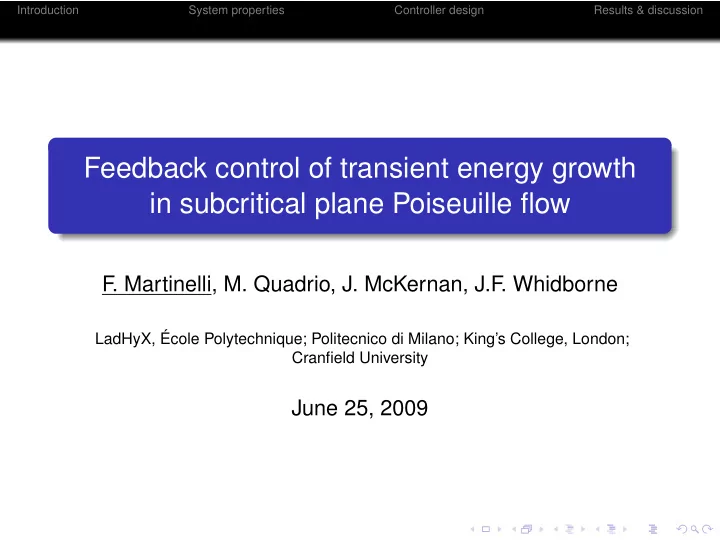

Introduction System properties Controller design Results & discussion Feedback control of transient energy growth in subcritical plane Poiseuille flow F . Martinelli, M. Quadrio, J. McKernan, J.F . Whidborne LadHyX, École Polytechnique; Politecnico di Milano; King’s College, London; Cranfield University June 25, 2009
Introduction System properties Controller design Results & discussion Motivation In subcritical plane Poiseuille flow: 1 Is complete feedback suppression of transient growth possible, when employing wall-based actuation? 2 How to design a feedback controller that directly targets the transient growth mechanism?
Introduction System properties Controller design Results & discussion Model of the system Orr-Sommerfeld-Squire stability equations, y discretization by Chebyshev expansion For each wavenumber pair ( α, β ) , wall actuation accounted for by a lifting procedure. Standard state-space form: x ( 0 ) = x 0 , ˙ x = Ax + Bu , ∀ α, β w l ) T (“vectorized” most general case: u = ( ˙ u u , ˙ u l , ˙ v u , ˙ v l , ˙ w u , ˙ transpiration at both walls). input: rate of change of transpiration velocity (due to lifting) rescaling of state variables: energy is || x || 2 = x H x
Introduction System properties Controller design Results & discussion Closed loop monotonic stability Theorem (Whidborne & McKernan, 2007) A static, state-feedback control law u = Kx exists such that the closed-loop system is monotonically stable if and only if: B ⊥ � A + A H � B ⊥ H < 0 or BB H > 0 , where B ⊥ is the left null space of B . Second criterion never satisfied using wall forcing First criterion verified numerically
Introduction System properties Controller design Results & discussion Numerical verification of the algebraic criterion 2D, v actuation, β = 0 3D, full actuation, Re = 120 Contours of T ( α, β, Re ) = λ max ( B ⊥ � A + A H � B ⊥ H ) It is not possible to completely suppress the transient growth mechanism by feedback wall forcing.
Introduction System properties Controller design Results & discussion Upper bound on maximum growth Linear, time-invariant stable system (open-loop): x ( 0 ) = x 0 ˙ x = Ax , Upper bound to the maximum transient energy growth G : G u = λ max ( P ) λ max ( P − 1 ) ≥ G . P = P H > 0 satisfies the Lyapunov inequality: PA + A H P < 0 .
Introduction System properties Controller design Results & discussion Minimization of the upper bound G u depends on the choice of P ; to minimize it: min γ : PA + A H P < 0 , P = P H > 0 I < P < γ I Linear Matrix Inequality (LMI) generalized eigenvalue problem. Last inequality ensures that γ > G u . Standard solvers exist.
Introduction System properties Controller design Results & discussion Feedback minimization of the upper bound Full-state feedback control law u = Kx . Closed loop dynamics: x ( 0 ) = x 0 . ˙ x = ( A + BK ) x , Lyapunov inequality: PA + A H P + PBK + K H B H P < 0 which is bilinear in K and P .
Introduction System properties Controller design Results & discussion Feedback minimization of the upper bound Introducing Q = P − 1 and Y = KQ , and an additional constraint such that max t ≥ 0 || u || 2 < µ 2 , the optimization problem reads: min γ : AQ + QA H + BY + Y H B H < 0 , Q = Q H > 0 I < Q < γ I Y H � Q � > 0 µ 2 I Y which is a LMI problem. Controller gains recovered from K = YQ − 1 .
Introduction System properties Controller design Results & discussion Effect of different actuation components - linear case Wave ( α = 1 , β = 1 ) . Vortex ( α = 0 , β = 2 ) . 70 800 Open loop Open loop u forcing 700 u forcing 60 v forcing v forcing 600 w forcing w forcing 50 500 40 E / E 0 E / E 0 400 30 300 20 200 10 100 0 0 0 10 20 30 40 50 0 50 100 150 200 250 300 350 400 t t Tests ( Re = 2000, µ = 100) show the bound γ is conservative of a factor ≈ 2.
Introduction System properties Controller design Results & discussion Closed loop transition thresholds Direct numerical simulations at Re = 2000: Pair of oblique waves: α 0 = 1 , β 0 = ± 1 Streamwise vortices: α 0 = 0 , β 0 = 2 Random noise (Stokes modes) on the array ( 0 , ± 1 , ± 2 ) α 0 and ( 0 , ± 1 , ± 2 ) β 0 , 1 % of total perturbation energy Controller designed on the same array, µ = 100 E ( thres ) Performance: improvement factor = 0 , control E ( thres ) 0 , free Improvement factor u v w Oblique waves ≈ 6 . 0 ≈ 20 . 7 1 Streamwise vortices 1 ≈ 2 . 0 ≈ 1 . 6
Introduction System properties Controller design Results & discussion Conclusions An algebraic criterion to identify the possibility of feedback suppression of transient growth has been presented. Closed-loop monotonic stability is not possible when using wall actuation in subcritical plane Poiseuille flow. A new, LMI-based control design technique – directly targeting the growth mechanism – has been proposed. In terms of transition thresholds modification, wall forcing with u and w components is less effective than forcing with v .
Recommend
More recommend